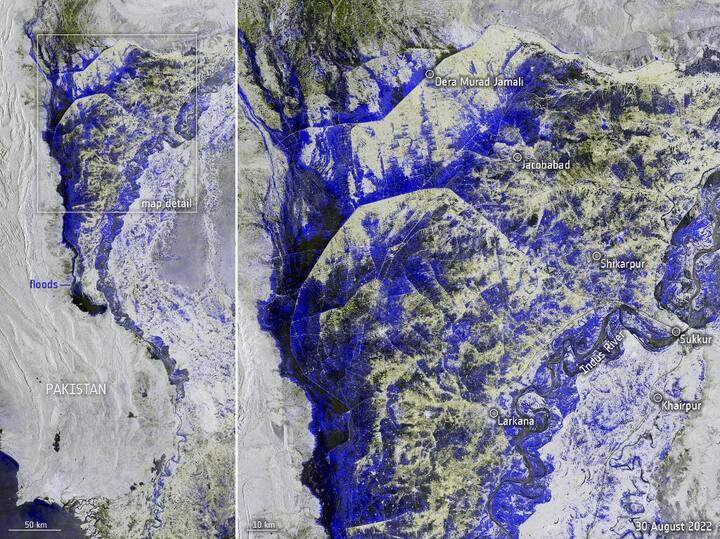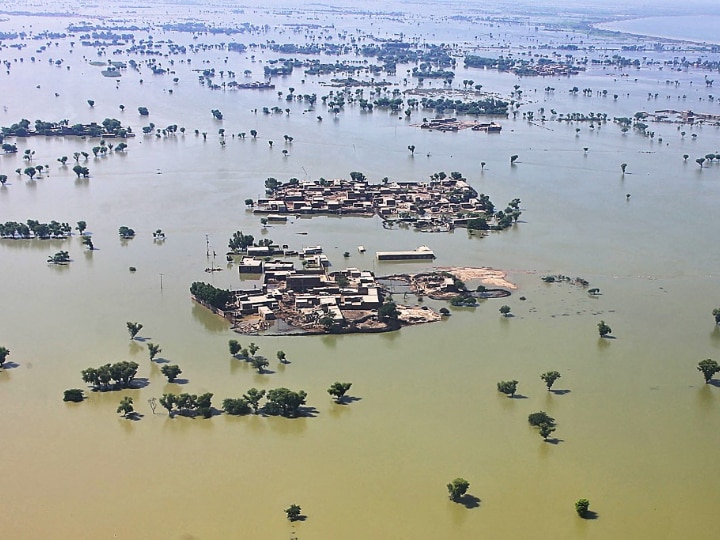New Delhi: Over a third of Pakistan is underwater as it faces the worst flood in history, images released by the European Space Agency show. The deadly flood waters threaten to create secondary disasters -- food is in short supply as most of its agricultural land is flooded and millions of livestock have been wiped out. Pakistan is also facing a severe health crisis brought about by the unprecedented rainfall.
The torrential monsoon rainfall has been ten times heavier than usual which has caused the Indus River to overflow and create a long lake several kilometres wide based on the ESA image taken on August 30.

Food Crisis in Pakistan
According to Action Against Hunger, nearly 27 million people in the country did not have access to enough food before the flood and now it is staring a widespread food shortage, ANI quoted a CNN report. Floods have impacted 2 million acres of crops and killed more than 794,000 heads of livestock across Pakistan, according to a situation report from the UN Office for the Coordination of Humanitarian Affairs.
"Our priority right now is to help save and protect lives as waters continue to rise. The scale of these floods has caused a shocking level of destruction -- crops have been swept away and livestock killed across huge swathes of the country, which means hunger will follow," Saleh Saeed, chief executive of the Disasters Emergency Committee, a United Kingdom-based aid coalition was quoted as saying by ANI.
Meanwhile, Prime Minister Shebaz Sharif, who was elected earlier this year, said on August 30 that people were facing food shortages and the price of basic items such as tomatoes and onions have "skyrocketed."
"I have to feed my people. Their stomachs cannot go empty," ANI reported Sharif as saying.
Sharif said that the floods were "the worst in the country's history" and estimated the calamity had caused more than USD 10 billion in damages to infrastructure, homes and farms.
Health crisis due to the flood
The World Health Organization (WHO) has also classified floods in Pakistan as an emergency of "the highest level," warning of a rapid spread of disease due to the lack of access to medical assistance.
WHO chief Tedros Adhanom Ghebreyesus warned of new outbreaks of diarrheal diseases, skin infections, respiratory tract infections, malaria and dengue in the aftermath of the floods, aside from which several waterborne diseases including infectious diseases also pose a threat to the country.
More than 1,100 people have died from the floods since mid-June, nearly 400 of them children, while millions have been displaced, according to Pakistan's National Disaster Management Authority (NDMA).
More than 33 million people have been affected, or about 15 per cent of the population, according to Pakistan's climate change minister Sherry Rehman. More than 1 million homes have been damaged or destroyed, while at least 5,000 kilometres of roads have been damaged, according to the NDMA, ANI reported.
Pakistan is responsible for less than 1 per cent of the world's planet-warming gases, European Union data shows, yet it is the eighth most vulnerable nation to the climate crisis, according to the Global Climate Risk Index, as per ANI. Pakistan was already grappling with political and economic turmoil and has been thrown into the front line of the human-induced climate crisis.
Pakistan's monsoon season usually brings heavy downpours, but this year has been the wettest since records began in 1961, according to the Pakistan Meteorological Department
(With ANI inputs)


